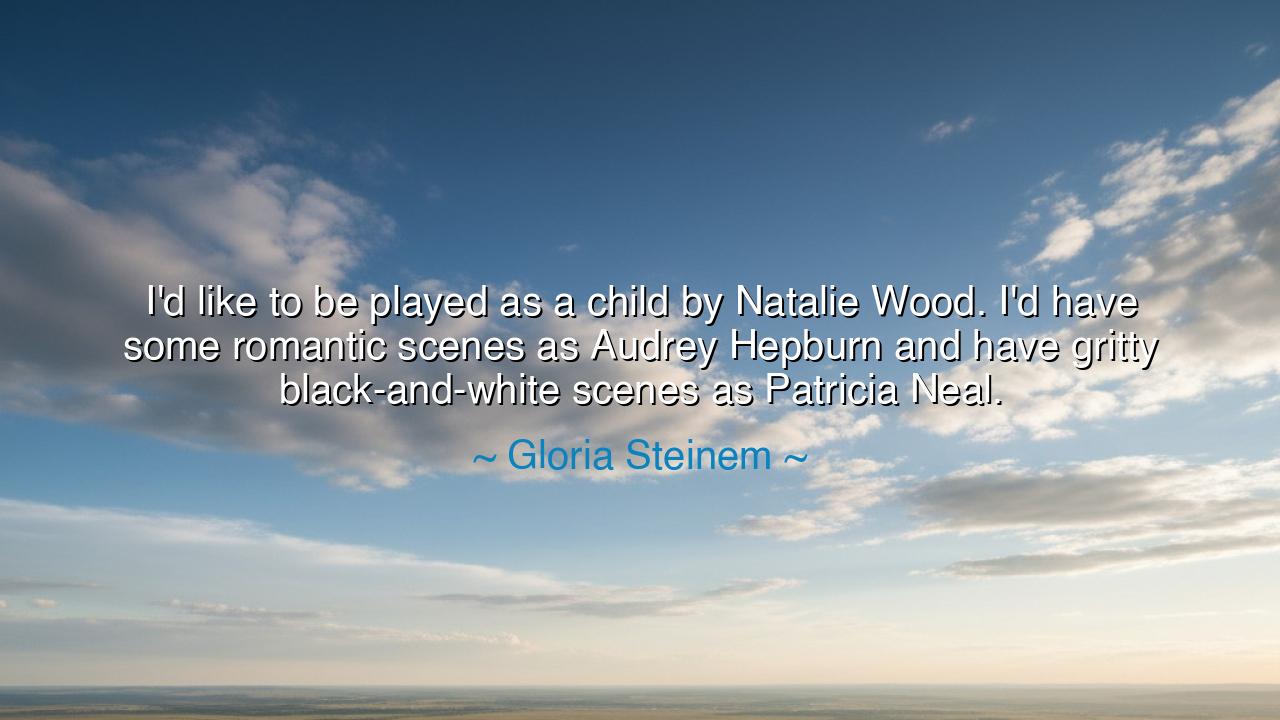
I'd like to be played as a child by Natalie Wood. I'd have some
I'd like to be played as a child by Natalie Wood. I'd have some romantic scenes as Audrey Hepburn and have gritty black-and-white scenes as Patricia Neal.






"I'd like to be played as a child by Natalie Wood. I'd have some romantic scenes as Audrey Hepburn and have gritty black-and-white scenes as Patricia Neal." – Gloria Steinem. In these words, Steinem is not merely fantasizing about playing iconic roles, but making a profound statement about the layers of identity and the complexity of being human. Her wish to be portrayed in such varied ways reflects the multifaceted nature of women’s lives—each woman is a tapestry, woven with different threads of innocence, passion, strength, and resilience. By invoking Natalie Wood, Audrey Hepburn, and Patricia Neal, Steinem highlights not just the roles these actresses played, but the archetypes they embodied—ranging from the childlike to the romantic to the gritty and empowered. Her desire to experience this variety speaks to the idea that no woman, or indeed no person, can be confined to a single role or identity.
In the ancient world, heroes were often defined by their complexity and their ability to embody both light and shadow. Take, for example, the myth of Achilles in the Iliad. Achilles, the great hero, is both a fierce warrior and a deeply human figure, struggling with his own emotions and weaknesses. He is a man of great strength and great vulnerability, someone who cannot be defined by one quality alone. Similarly, the Greek god Apollo, though a god of music, prophecy, and healing, also has his darker side, marked by his jealousy and his violent actions. The ancients understood that the essence of a person—whether divine or mortal—could not be reduced to a single characteristic. Complexity is not a flaw, but rather the source of depth, and this is the idea Steinem touches upon with her wish to embody multiple personas.
Steinem’s reference to Natalie Wood, known for her delicate and youthful charm, represents the innocence and vulnerability of youth, much like the ancient tales of Persephone, who is both a daughter and a queen, a figure caught between the innocence of spring and the darker forces of the underworld. Wood’s roles often captured the fragility of youth, a quality that is both tender and precious, yet vulnerable to the harsh realities of life. Similarly, Steinem's desire to channel Audrey Hepburn, known for her grace, elegance, and romantic roles, highlights the enduring power of love, beauty, and passion—qualities that have often been idolized in both women and men throughout history. In Hepburn’s roles, there is a reminder that romantic love is both transformative and complex, something that can be both gentle and fierce in its intensity.
However, Steinem does not stop there. By invoking Patricia Neal, an actress known for her gritty, dramatic roles that explored the depths of human struggle and strength, Steinem points to the resilience that women, and all people, must summon in the face of adversity. Neal often portrayed women who were flawed, complex, and facing life’s harshest realities. In this reference, Steinem is embracing the idea that women are not just romanticized figures of beauty and grace but are also filled with grit, determination, and the ability to survive and thrive through hardship. This multifaceted view of women as nurturing, romantic, and tough is one that has often been overlooked in a world that tends to place people into fixed categories.
In the **story of Medea, the ancient tragedy by Euripides, the title character embodies this conflict. Medea, the loving mother, is also the betrayed wife and the avenger who takes drastic, violent action to reclaim her dignity. She is a woman torn between her nurturing love for her children and her burning desire for justice and revenge. This tension between the feminine archetypes—love and vengeance, grace and rage—speaks to the complexity of human nature that Steinem calls attention to. She desires to be portrayed as a woman who, like Medea, is all-encompassing, not limited to one role or emotion but capable of both softness and strength, romance and resilience.
Steinem’s lesson is a call to reject the narrow definitions that society imposes on people, especially women. The women she invokes—Wood, Hepburn, and Neal—represent different dimensions of womanhood, showing that to be fully human is to embody multiple facets of identity. This is a reminder that we are not defined by one characteristic, role, or phase of life. Each of us contains multitudes, and growth comes from allowing ourselves to express and experience those different layers. In life, we should not feel confined by the roles society assigns to us, but instead embrace the depth of our personalities and our experiences, knowing that we, too, can be tender and strong, vulnerable and fierce, romantic and gritty.
In our own lives, we must remember that to be truly whole is to accept and celebrate all the different aspects of ourselves. Don’t shrink from the parts of you that are complex or contradictory; they are not weaknesses, but the very stuff of which great stories are made. Embrace the multifaceted nature of your identity, and allow yourself the freedom to live as the full, vibrant person you are, just as Steinem imagines herself being portrayed—in all her complexity. In doing so, we create lives that are not defined by external expectations but by the authenticity of our own experiences. Live fully, embrace the many roles you play, and, like the great characters of literature and film, find the strength and beauty in each facet of who you are.






AAdministratorAdministrator
Welcome, honored guests. Please leave a comment, we will respond soon